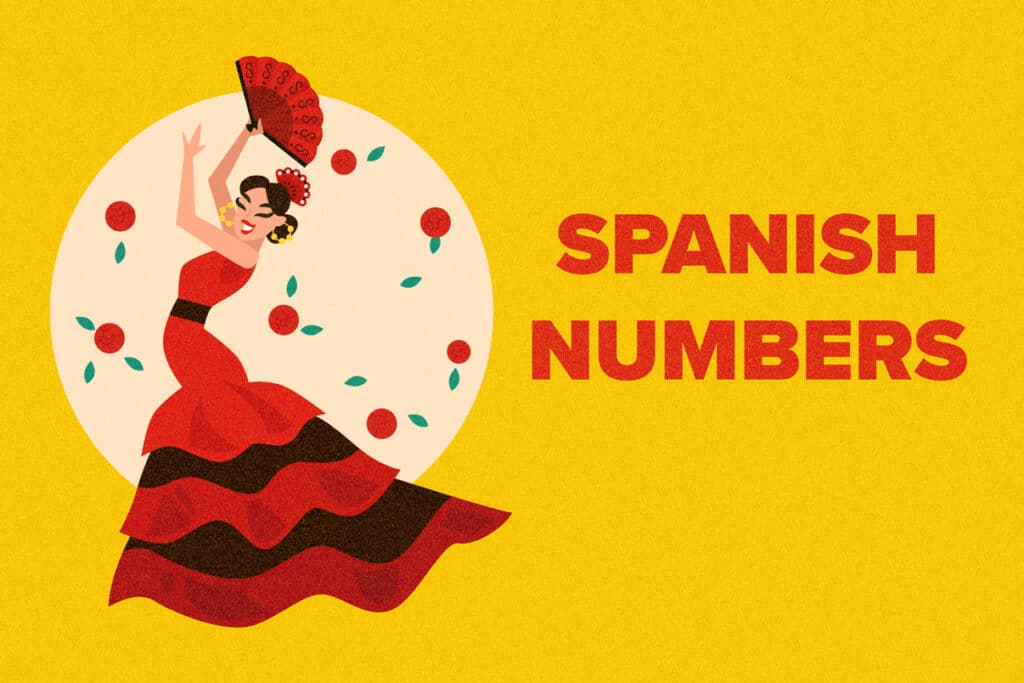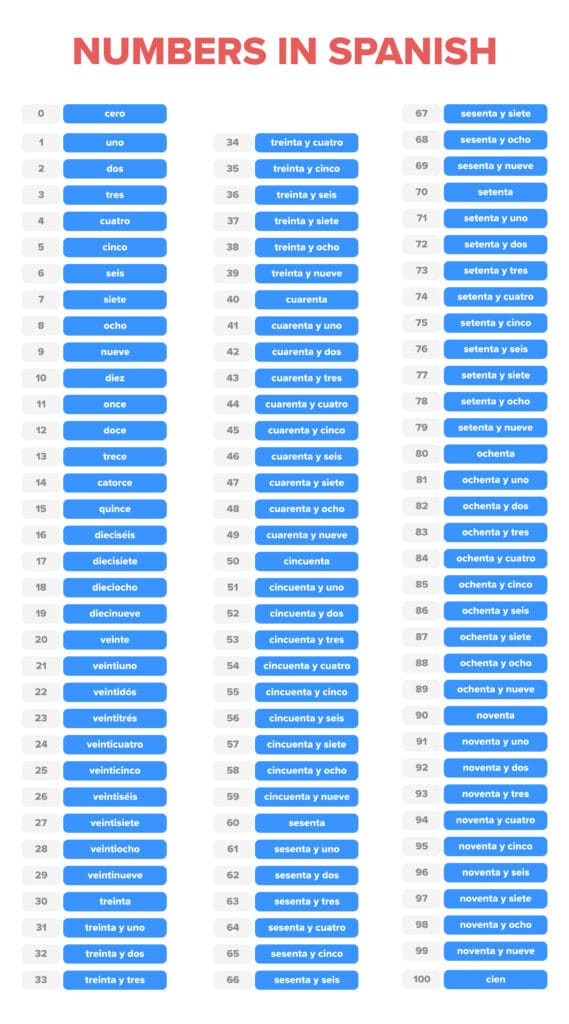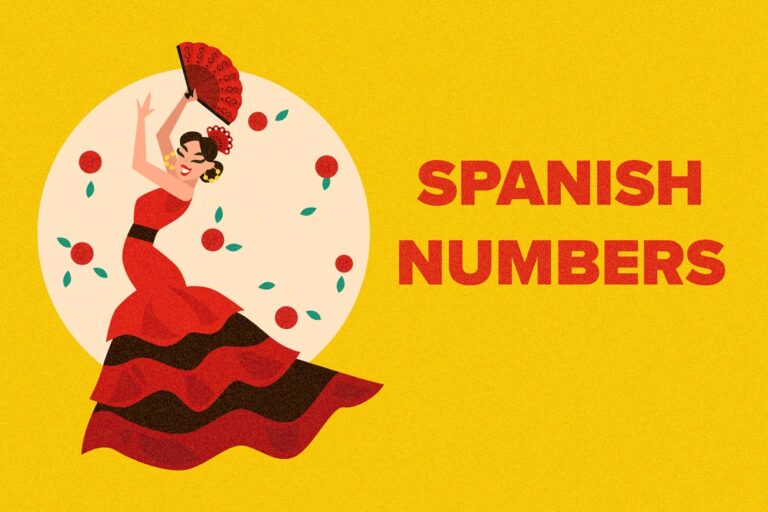
Addresses, time, dates, cooking, measurements. All of these have something in common.
Numbers!
Knowing how to count in Spanish is a vital skill—almost everything involves numbers in some way, from asking for the time, to giving your age, to watching a Spanish documentary about a historic event.
In this post, you’ll learn everything you need to know about Spanish numbers, including how to count from one to a billion, grammar rules for numbers, ordinal numbers and more.
Contents
Download:
This blog post is available as a convenient and portable PDF that you
can take anywhere.
Click here to get a copy. (Download)

Spanish Numbers
Spanish Numbers 1 to 30
1 — Uno
2 — Dos
3 — Tres
4 — Cuatro
5 — Cinco
6 — Seis
7 — Siete
8 — Ocho
9 — Nueve
10 — Diez
Spanish Numbers 11 to 30
11 — Once
12 — Doce
13 — Trece
14 — Catorce
15 — Quince
16 — Dieciséis
17 — Diecisiete
18 — Dieciocho
19 — Diecinueve
20 — Veinte
21 — Veintiuno
22 — Veintidós
23 — Veintitrés
24 — Veinticuatro
25 — Veinticinco
26 — Veintiséis
27 — Veintisiete
28 — Veintiocho
29 — Veintinueve
30 — Treinta
Notice that dieciséis (16) is made up of diez (10) and seis (6), which together make 16. This idea of combining numbers will be a common theme throughout this post.
Spanish Numbers 40 to 100
40 — Cuarenta
50 — Cincuenta
60 — Sesenta
70 — Setenta
80 — Ochenta
90 — Noventa
100 — Cien
Note that to make specific numbers past 30, you have to use y (and) to connect the 10s with the 1s. For example:
33 is treinta y tres
65 is sesenta y cinco
For more practice with Spanish numbers 1 to 100, I recommend watching this comprehensive video from Butterfly Spanish on YouTube:
Spanish Numbers 100 to 1000
100 — Cien
200 — Doscientos
300 — Trescientos
400 — Cuatrocientos
500 — Quinientos
600 — Seiscientos
700 — Setecientos
800 — Ochocientos
900 — Novecientos
1,000 — Mil
Note that cien is only used to say 100 even—anything above that and we’ll use ciento.
There’s also no y used with these larger numbers because the y is only used to separate the 10s from the 1s (42 = cuarenta y dos) but not the 100s from the 10s (142 = ciento cuarenta y dos).
So, following this pattern, 104 is ciento cuatro. 147 is ciento cuarenta y siete not ciento y cuarenta y siete.
Spanish Numbers 1,000 and Beyond
Thousands
Beyond one thousand, you use the appropriate number to signify how many thousands you have. For example:
2,000 — Dos mil
3,006 — Tres mil seis
46,000 — Cuarenta y seis mil
46,155 — Cuarenta y seis mil, ciento cincuenta y cinco
Note that after mil, in Spanish, we use a period to separate our numbers instead of a comma, like we use in English. So 100,000 in English becomes 100.000 (cien mil).
Millions
Congratulations, you can now use these rules to count up to a million!
A million in Spanish is un millón or 1.000.000.
Let’s look at some examples:
4.000.000 — Cuatro millones
4.000.800 — Cuatro millones ochocientos
6.986.410 — Seis millones, novecientos ochenta y seis mil, cuatrocientos diez
Billions
And a un billón (a billion)? Well, that depends on which system you’re using, as there’s some debate about how many a billion actually is.
Officially, the whole world has now decided to go with the U.S. system, where a billion is a thousand million. But in practice, how many millions there are in a billion varies wherever you are.
If you need to be precise, it might be worth asking ¿Cuánto es un billón? (How much is a billion?).
The best way to pick up on these number rules is to immerse yourself as much as possible and listen to how natives pronounce things.

For example, you could use FluentU to watch authentic Spanish videos featuring native speakers in a variety of different contexts. Each video also comes with interactive subtitles, which let you hover over new words and structures you don’t know.
This is a pretty easy way to catch Spanish numbers used “in the wild” and learn other new terms in context.
Rules for Spanish Counting
- Cien is used as an adjective before nouns, such as: cien naranjas, cien días. It’s also used as an adjective when followed by the numbers mil, millón, billón (ie. cien mil, cien millones, cien billones).
- Use ciento when attaching smaller numbers in the 10s and 1s: ciento cuarenta, ciento sesenta, etc. It’s also used in expressions or refrains, usually coming from old Spanish.
- When a noun is masculine, uno becomes un. For example, un espejo (one mirror). We also shorten other numbers that end in uno to ún (note the accent). So it’s veintiún espejos (21 mirrors) because espejos is masculine.
- When a number ends in ientos, the adjective (the number) agrees with the noun (the thing we are counting). For example: Seiscientos espejos, seiscientas mesas, etc.
Using Ordinal Numbers in Spanish
Ordinal numbers are words that describe a sequence or order, like “first,” “second,” “third,” etc.
We don’t use ordinal numbers for the date in Spanish (like in English), but you do need them to talk about things like floor numbers, directions and who has won competitions (she won first prize, for example).
1st — Primer (o/a)
2nd — Segundo (a)
3rd — Tercer (o/a)
4th — Cuarto (a)
5th — Quinto (a)
6th — Sexto (a)
7th — Séptimo (a)
8th — Octavo (a)
9th — Noveno (a)
10th — Décimo (a)
Note that these words are adjectives (because they describe a noun), so you have to make them masculine, feminine or plural, depending on what you’re talking about. For example:
El primer piso (the first floor)
Ella es la primera (she’s the first)
Son los primeros a ir de viaje en nuestro familia (They’re the first ones to go on holiday in our family)
Spanish Numbers Practice Quiz
Let’s put your new Spanish numbers knowledge to the test with a 10-question quiz!
Translate the following numbers into Spanish, then view the answer key below to check your answers:
a) 185
b) 167
c) 125
d) 103
e) 199
f) 1,233
g) 800,650
h) 6th, 7th, 8th
i) 999,999
j) One hundred billion
Answer key:
a) 185 = ciento ochenta y cinco
b) 167 = ciento sesenta y siete
c) 125 = ciento veinticinco
d) 103 = ciento tres
e) 199 = ciento noventa y nueve
f) 1,233 = mil doscientos treinta y tres
g) 800,650 = ochocientos mil seiscientos cincuenta
h) 6th, 7th, 8th = sexto, séptimo, octavo
i) 999,999 = novecientos noventa y nueve mil novecientos noventa y nueve
j) One hundred billion = cien mil millones
So there you have it.
Spanish numbers are as easy as one, two, three—or uno, dos, tres!
Download:
This blog post is available as a convenient and portable PDF that you
can take anywhere.
Click here to get a copy. (Download)



